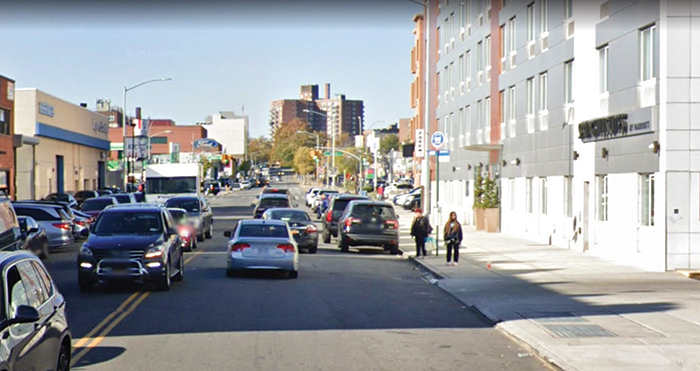Photo Courtesy of Google
Queens Boulevard from Queens Plaza to Jamaica Avenue had 10 pedestrian fatalities and 6.4 pedestrians killed or severely injured per mile from 2012-2016. The KSI figure declined 36 percent in 2017-2021.
By Forum Staff
City Department of Transportation Commissioner Ydanis Rodriguez on Tuesday announced the release of the updated Vision Zero Borough Pedestrian Action Plans, a detailed report with data on safety progress made at intersections, corridors and areas first identified in 2019’s version of the report.
Covering the past four years since the last update, the report highlights significant safety improvements and results as NYC’s pedestrian fatalities plummeted. According to the report, each borough saw dramatic decreases in pedestrian fatalities since the 2019 study period, with a 25 percent drop in Queens; 40 percent in the Bronx; 38 percent in Brooklyn; 45 percent in Manhattan; and a 38 percent decline on Staten Island.
The update also identifies 349 new Vision Zero Priority Corridors and Intersections in all five boroughs.
The update shows significant safety improvements were made at previously identified locations as NYC’s overall citywide pedestrian fatalities declined by 10 percent between 2014-2021, bucking national trends in which pedestrian fatalities have risen in the same period by over 50 percent—to a four-decade high. Under the Adams administration, DOT exceeded its commitment to bring safety improvements to 1,400 intersections in 2022, when pedestrian fatalities declined 4.8 percent, and overall traffic fatalities declined for the first time in three years.
Rodriguez indicated that DOT continues to focus its resources on Vision Zero Priority Locations (which include corridors, intersections and overall areas) where pedestrian KSI (killed or severely injured) crashes are concentrated. The report highlighted several case studies in each of the boroughs where a location was identified for Vision Zero safety treatments based on KSI numbers and was subsequently improved, including:
- Queens Boulevard from Queens Plaza to Jamaica Avenue, also a 2019 Priority Corridor, had 10 pedestrian fatalities and 6.4 pedestrians killed or severely injured per mile from 2012-2016. The KSI figure declined 36 percent in 2017-2021 with four pedestrians killed and 4.1 pedestrians killed or severely injured. DOT made significant upgrades to the corridor in 2021, with a protected bike lane, painted pedestrian path, new pedestrian crossings and new traffic controls, along with traffic lane removal.
The updated report issued Tuesday also highlights the improvements DOT made during the first nine years of Vision Zero (2014-2022):
- Nearly 800 Safety Engineering Projects completed
- Over 5,500 Leading Pedestrian Intervals (LPIs) installed
- Over 20 million automated speed camera violations issued
- Nearly 900 Vision Zero Priority locations visited by Vision Zero Street Teams
- Over 3,600 school and senior center visits for safety education in Priority Locations
“Under Vision Zero, we are constantly taking a fresh look at Priority Locations so we can dedicate the necessary resources to the communities, corridors and intersections where fatalities and serious injuries occur,” Rodriguez said. “As we complete that work and follow the data, our list of priority locations changes. Last year, under Mayor Eric Adams, we exceeded our commitments for addressing intersections—and with his leadership and dedication to Vision Zero, we will work every single day to keep pedestrian fatalities on the decline.”

